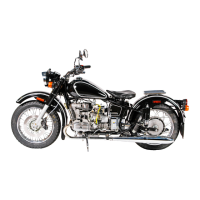49
After patching, let the surface dry in air for 15 minutes. Then proceed with drying at 212°F-248°F/
100°C-120°C with the aid of heat reflector or an electric lamp until the coat is perfectly dry.
Bear in mind that enamels are flammable. Color match may not be perfect due to humidity, fading,
temperature and other variables.
The painted surfaces of the motorcycle feature natural gloss. In case some dull spots appear,
remedy them by polishing as follows. Take a solution of wax polishing compound and having
washed the dull spots thoroughly, smear a thin film of the compound with a soft wad (cotton, cotton
gauze or flannel) over the surface. Rub the polishing compound making circular motions with the
wad. In 3 - 5 min. of drying, wipe the surface with a clean dry piece of cloth or flannel until luster
appears.
PRESERVATION AND STORAGE
If the motorcycle is put in storage for the season, arrange it on supports and proceed with the
preservation treatment. Check that the wheel tire pressure is within specifications. Store the motor-
cycle away from acids, alkalis, mineral fertilizers and other harmful substances.
Prior to placing it in storage, clean the bike thoroughly, drain the carburetors, or start the engine
and let it run with the gasoline cock closed to remove gasoline in the float chambers of carburetors.
Then spray storage oil (WD40) into each cylinder through the spark plug holes. Turn the crank-
shaft by depressing the kick lever pedal to distribute lubricant over the interior of the cylinders.
Lubricate the surfaces of chrome and zinc plated parts with a rust inhibitor. Smear all the points
provided with grease cups with commercial grease. Seal the outlet holes of the mufflers.
Before starting a trip on the motorcycle that was under preservation, proceed with the jobs listed in
the section “Pre-Trip Preliminaries”.
Winter Considerations
Motorists in many areas of the US experience the use of salt and other chemicals that are applied
to road surfaces in the winter.
Salt or other caustic chemicals should always be removed from your bike’s surfaces with fresh
water as soon as possible.
Undercoating of fenders is recommended for those areas with salt and/or fine gravel or sand. See
your dealer for details.

